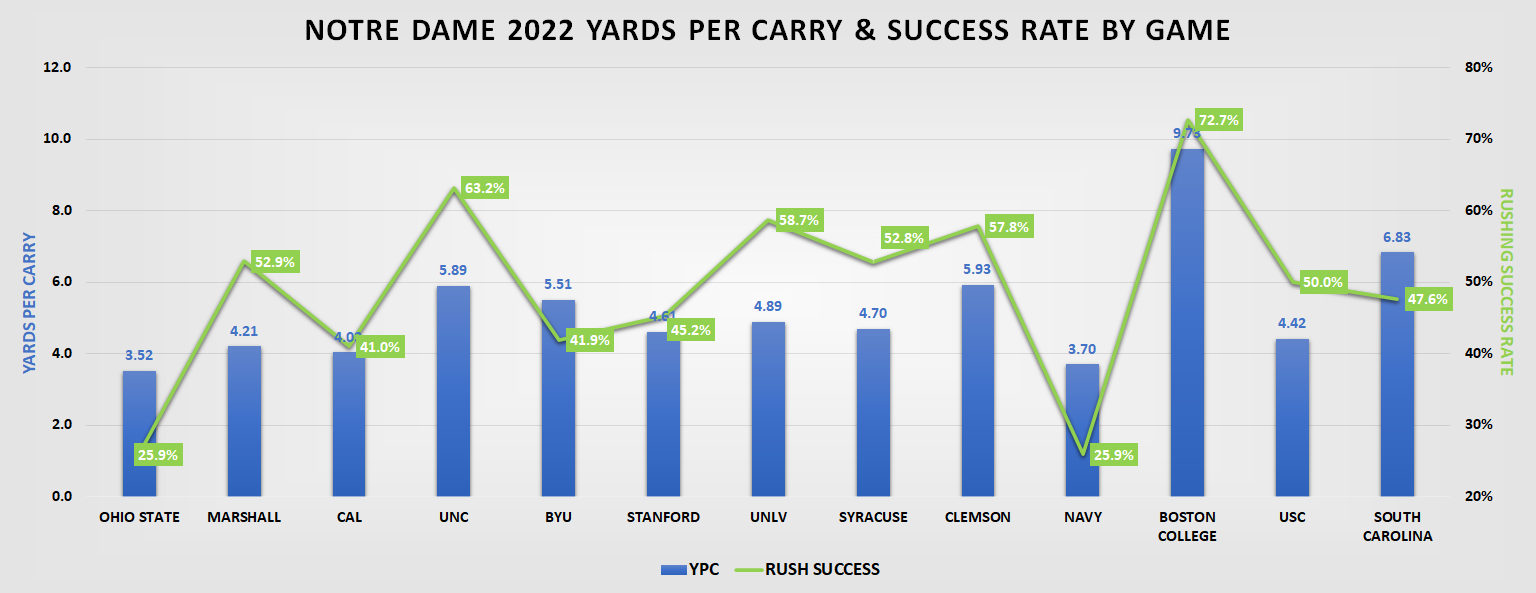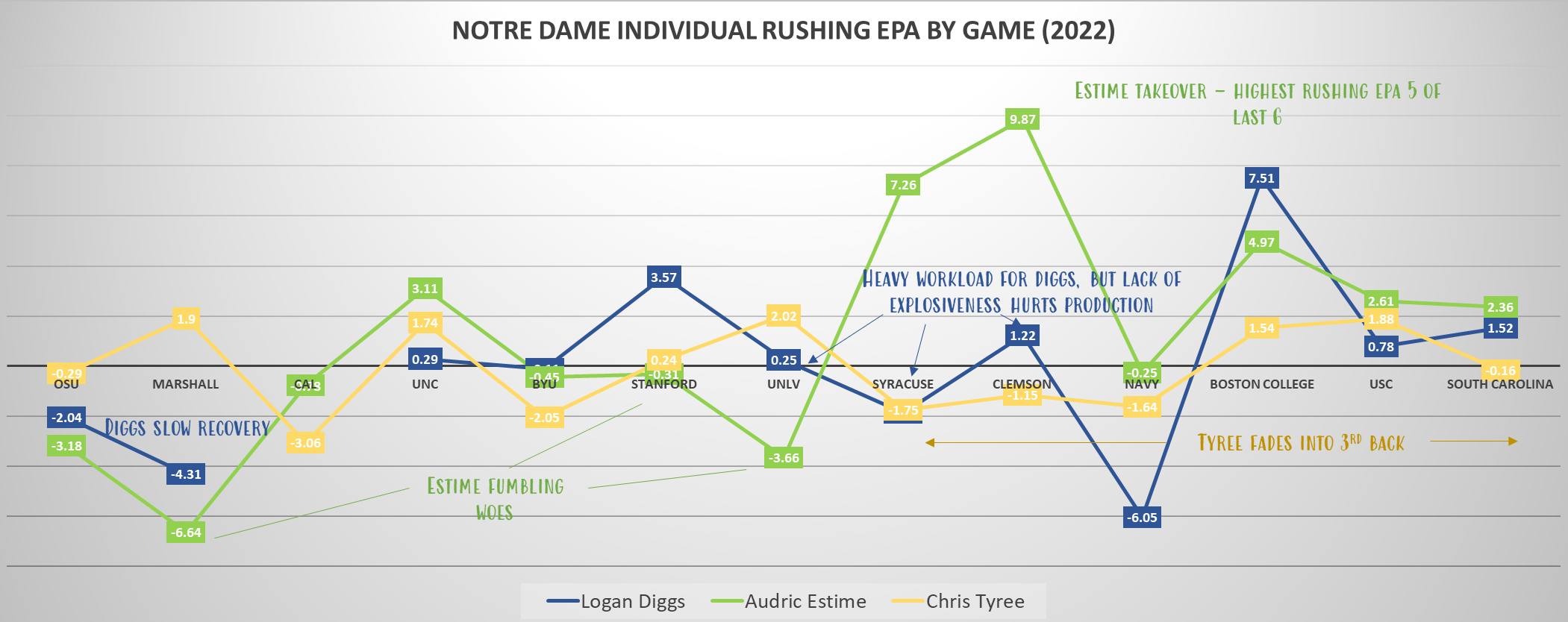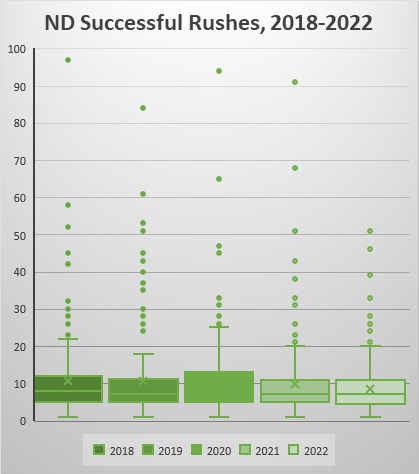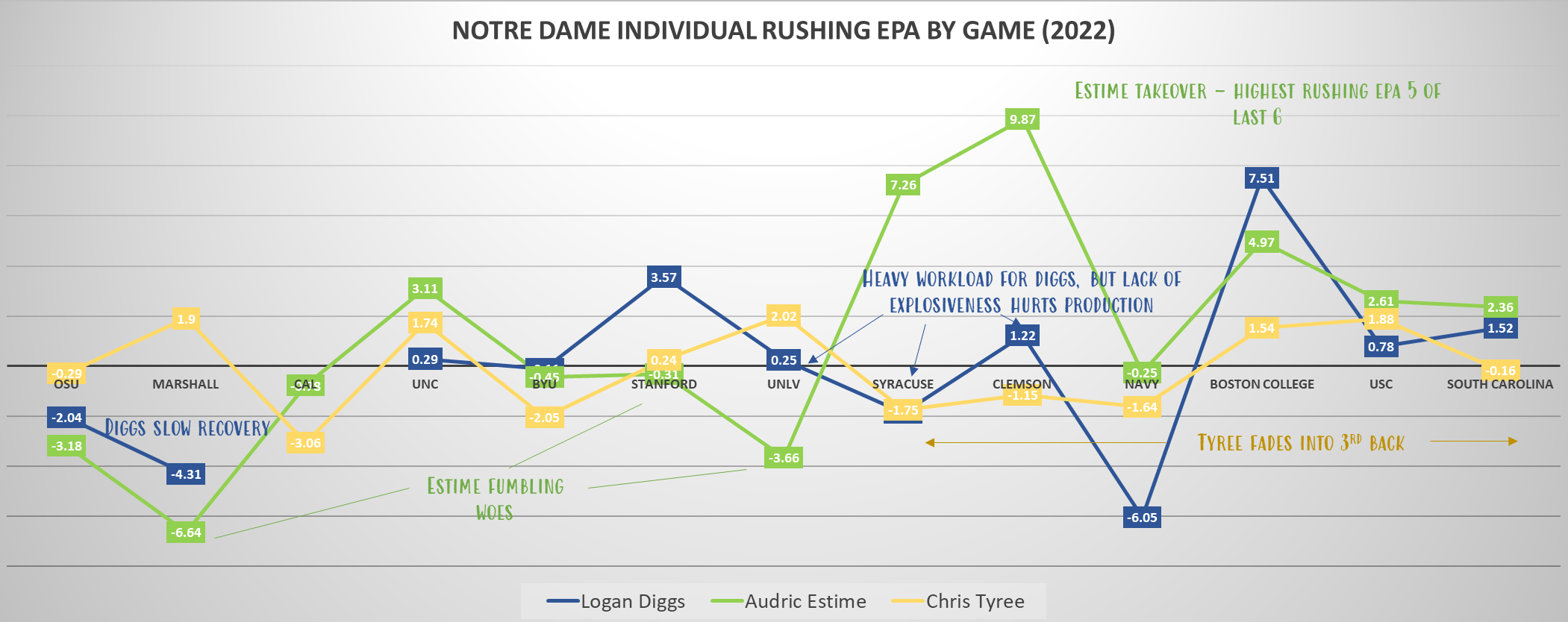The annual offseason breakdowns + previews return! As in past summers, I’ll be breaking down the performance of each unit – passing and rushing offense and defense – with a look ahead to 2023 and what this means for the Irish. First up is the Notre Dame run game, a unit that showed dominant potential but struggled with game-to-game consistency and strangely performed poorly against several of the worst defenses on the schedule.
Flashes of brilliance mixed with no-shows on the ground

One of the challenges evaluating Notre Dame’s rushing performances in 2022 is that they feel random week to week and detached from the quality of the opponent. Consecutive weeks saw the Irish run all over a loaded Clemson front and then struggle to get anything going against Navy. ND shredded some weak defenses like UNC and Boston College, but two of their worst rushing performances came against USC and Stanford defenses, two of the weakest in FBS against the run (125th and 131st, respectively).
You’ll notice above that this inconsistency meant the Irish couldn’t just pound it down opponents’ throats when needed. In each of Notre Dame’s losses, the Irish were between 3.5 – 4.6 yards per carry, even if only Ohio State shut down the run game efficiency (with an injured Jarrett Patterson, it has to be noted).
The other confounding factor evaluating the running game is the passing attack’s lack of assistance. With Drew Pyne often struggling and a thin wide receiver group, the smart move for opposing defensive coordinators was loading up against the run. Sometimes the Irish were able to run anyway (Syracuse, Clemson); other times, Pyne was able to take advantage through the air (Navy, USC), but occasionally this stymied the ND offense (OSU, Marshall, Stanford).
How much of a boost would a more dangerous spread passing attack have offered? Or just a quarterback that forced defenses to account for him? With Sam Hartman and a receiving group with plenty of upside, we’ll see if things open up at least a little bit this fall.
The 2022 numbers showed a clear pecking order, and RB1 is still here
The hierarchy at running back seemed to ebb and flow through the 2022 season. Audric Estime appeared to be the lead back in the opener against Ohio State, with Chris Tyree in a complementary role. Logan Diggs playing early was a surprise as he continued to recover from a torn labrum, but he appeared limited early (both in workload and ability). Tyree earned 15+ carries in wins over Cal and UNC but then averaged just five rushes over the final six games of the year. Estime went through a rough stretch with three lost fumbles in four games in the middle of the year, which led to a dip in snaps and production. In hindsight, Diggs probably was rushed back too early – he had just 16 yards on 11 carries against Ohio State and Marshall, then missed the Cal game.

Despite those shifts and the NBC broadcast team’s unending desire to call the RB group a “three-headed monster,” there were clear differences in production. Heading into the spring, my concern was that Estime might remain something less than the leading rusher, “the guy,” RB1A, etc. Estime’s efficiency and ability to create positive yards aren’t shocking, but leading the room in explosiveness despite his “big back” stereotype is eye-opening. After another year with Matt Balis, Estime has trimmed down a bit, ideally with the ability to maintain his ability to break tackles but adding additional agility and top-end speed. With Diggs transferring to LSU, the concerns now flip from wondering if the workload will be big enough to ensuring longevity and sustainability.

Despite the slow start, Diggs closed the season on a high note, with 1/3 of his explosive runs coming in the final three games (which doesn’t include his 80-yard touchdown catch against South Carolina). The downside to Diggs’ patient style is that it sometimes leads to negative plays when a running lane doesn’t materialize, leading to a 33% higher stuff rate than the other backs. There were also some questionable usage patterns at play – for example, Diggs received 19 carries in power run scenarios (3rd/4th and two or less). His success rate (68%) was pretty pedestrian in these situations, and it seems odds he had double the power run carries than Estime (although the “mini-Bus” was only 5 of 9).
It felt like a “now or never” season for Chris Tyree as a junior, and while things weren’t that black and white, the answer felt more like “never.” Tyree’s physical strengths – explosiveness, versatility, acceleration – have yet to translate on-field and into consistent production. It felt like the scheme and limitations of the 2022 offense hurt Tyree more than other backs, but his inability to break tackles or make defenders miss means it requires perfectly blocked plays for him to produce at the level of the other backs. The passing game deep dive will explore this more, but his receiving numbers also don’t stand out positively from the other running backs, so the transition to full-time wide receivers will be fascinating to watch.
What role will QBs play in the run game?
By design, QB runs are some of the highest-value rushes possible. You have an extra blocker, and statistically, a failed scramble gets counted as a sack (dinging passing numbers), while a successful one shows up positively. As a result, it’s more telling to look at quarterback rushing production within the position group.

Drew Pyne starting ten games was not helpful to the run game. Pyne’s athletic limitations meant defenses didn’t have to really account for QB runs or worry too much about his scrambling. Tommy Rees had to get creative and use a tight end to run sneaks in short-yardage scenarios. Lanes were more congested for running backs as a result.
Is it concerning that Sam Hartman’s numbers look even worse? I don’t think so. Neither will ever be more than a counterpunch in the rushing attack, and Wake’s slow mesh scheme plus poor run game set Hartman up for failure on many of his attempts. Like Pyne, he’ll occasionally surprise defenses by keeping the ball or taking easy scrambling yards. But Hartman’s most significant contribution to the rushing game will be what his arm and willingness to take shots downfield do to opposing defenses.
Before the transfer to reunite with Tommy Rees and Alabama, the question about quarterbacks and the Irish run game was whether a Buchner package might be deployed in short-yard or goal-line scenarios. Buchner’s rushing production in his limited appearances was mediocre, but the OL was a mess then, and OSU and Marshall finished 11th and 3rd in Rushing EPA per play allowed. His performance in 2021 (7.7 yards/carry) and in the bowl game against South Carolina (8.2 yards/carry, 80% success) indicates Buchner’s rushing upside more. It would have been fascinating to see the new staff weigh the pros and cons of taking Hartman off the field in these critical snaps, but now the QB room consists entirely of more “pro-style” vs. “dual threat” personnel.
The 2022 OL excelled at generating 3-4 yards. Can they take the next step?

Looking at the last five seasons, 2022 stands out for being confusing and less cohesive than others. The rushing efficiency was the highest since 2017 – and by a decent margin – yet it didn’t translate into production like in other years. The ND running attack was very good at picking up medium gains, just ok breaking explosive runs, and poor at producing the long runs that are incredibly valuable and pull up that yards per carry average.
Notre Dame ranked 49th nationally in the percentage of carries gaining 10+ yards, but the higher you raise the explosive run bar, the worse the Irish fare. The rushing attack was 70th in 20+ run rate and T109 in 30+ yard gain rate. Add this all up, and you will find a Navy-like profile with the 20th-best rushing efficiency and the 94th-best explosiveness. You can see this visualization neatly compared to other recent ND rushing attacks below:

If the offense can sustain a similar efficiency level, the Irish should see some positive regression in breaking these long gains. Opening up the playbook may help too – with Pyne under center, Notre Dame often defaulted to run-run-pass scripts as default to ensure the offense stayed out of 3rd and long situations.

The danger in this line of thinking is taking the run-blocking efficiency as a given. Especially down the stretch, the Irish in 2022 were excellent in creating positive rushes and avoiding negative gains. While there’s reason for optimism with two elite tackles and a solid veteran under center, it’s still an offseason of transition. Offensive line is often a “weak-link” unit where weaknesses can matter more than strengths, and replacing two new starters with a new position coach and offensive brain trust won’t be straightforward.
The 2023 floor is high – can the ceiling push up even with new pieces?
On paper, this should be the most dangerous Notre Dame rushing attack since 2020. It starts up front with Alt and Fisher as an All-American caliber tandem at the tackles and Correll as a veteran leader in the middle who has seen it all. There’s nearly a decade of experience to replace at the guard spots with Jarrett Patterson and Josh Lugg graduating, but many potential answers. It will be a failure if the staff can’t find and develop solid guard play between the mix of young talent (Billy Schrauth, Rocco Spindler) and experienced upperclassmen (Andrew Kristofic, Michael Carmody, Tosh Baker, if he gets a look inside?) in the position room.
The running back room takes a hit losing Diggs’ experience and production, but Estime is a monster. If he continues to improve in critical areas – namely pass protection and explosiveness – it’s not crazy to think he’ll be a major postseason award finalist. Depth is a touch thinner than ideal, but Gi’Bran Payne had a nice spring, and there’s the potential of Jadarian Price and Jeremiyah Love waiting in the wings.
Success rate vs. Stuffed rate, selected returning RBs
Success rate = The rate the player made a successful play via a run
Stuffed rate = The number of runs this player made that went for no gain or negative yards per attempt pic.twitter.com/3BFxIOgKmj— yahia hassan (@yhassan00) May 27, 2023
The three swing variables are Gerad Parker’s ability to scheme up a strong attack, the passing game’s ability to keep defenses honest, and the guard play. How each plays out will play a big role in how effective Notre Dame’s rushing attack can be. The floor feels very high – there’s too much talent and depth across the offense for the bottom to fall out, barring catastrophic injuries. The ceiling is a top-10 rushing attack nationally, but that will require almost everything going right.
Base projection: A top-20 rushing attack that’s effective but not consistently dominant
While not every metric is a lock to improve, the productivity and reliability of the rushing attack as a whole project to be better in 2023. The efficiency of 2022 is a strong foundation to build from, and most of the key pieces that enable that success remain intact. If I’m betting on anything, the complementary passing attack with Hartman significantly boosts the rushing productivity by opening things up more. Pair this with some positive regression expected with explosiveness, and it’s not a complicated formula for an effective run game.
The limitations may sound familiar. The question marks at the guard spots (and blocking from the tight end position) could hold back consistency. It’s a significant leap from 2022 – first to regularly dominating the mid-tier ACC opponents on the schedule to being able to run effectively against elite defensive talent (Ohio State, at Clemson). If Estime goes down or the case of the fumbles returns, the talent level could drop off substantially if the young supporting cast isn’t quite ready.
Breaking into the top 10 without a rushing threat at QB is difficult. It requires dominance in the trenches, backs hitting semi-regular home runs with long gains, and usually a dangerous passing attack to complement. For Notre Dame’s running game to reach this ceiling, a lot has to break near-perfectly for the offense.
Low projection: Too many moving parts and inconsistency led to a disappointing season
A worst-case scenario isn’t a disaster, but it looks and feels like 2021 and 2022 on the ground, with many highs and lows that are sometimes opponent dependent and sometimes random due to inconsistency. The ingredients to a stagnant run game feel like the following:
- The offensive line takes a long time to gel – the new guards have tough stretches, the Hiestand to Rudolph (and Parker play-calling) isn’t smooth, and injuries cause some of the most important linemen to miss games
- Despite Hartman, the young receivers and the downfield passing game still doesn’t scare opponents enough, and defenses continue to congest rushing lanes and dare the Irish to throw to win.
- The backs continue to struggle to break big runs, putting pressure on the offense to turn long drives into points
Even two of those scenarios could result in Notre Dame struggling offensively with a few too many of the pesky ACC opponents like NC State or Duke or finding themselves dependent on the passing game against Ohio State and Clemson’s fronts.
High projection: The passing game opens things up for an explosive and reliable attack
Let’s end on a positive note! In a perfect world, the offensive line wins the Joe Moore Award, led by the All-American tackles. Schrauth and Spindler nail down the guard spots and perform well, locking their spots in as starting guards for the next few seasons. The passing attack hums – Hartman and his new receiving weapons (Merriweather, Thomas, Colzie, Tyree) force defenses to spread out or risk getting beat deep or on the perimeter for easy first downs.
The balanced offensive attack clears the way for Estime to pile up yards, averaging over six yards per carry with strong efficiency. With help from Payne and JD Price, the backs turn more singles into doubles and doubles into home runs with chunk plays and strong downfield blocking from the big receivers and tight ends. Notre Dame excels in 3rd and 4th in short, leveraging the line and versatility to keep defenses off balance, including key conversions in the biggest games on the schedule. The rushing attack is the backbone, even with an improved passing game, allowing the offense to keep pace with Ohio State and USC while limiting possessions in South Bend and letting the offense settle in comfortably in Death Valley.





Yes, this bugged me a lot last year. Very weird.
Those Navy numbers, yowza. Man was that second half bad.
I’m curious to see if Navy replicates their zero blitz strategy this year. Probably not, you have to assume Hartman would torch them for doing so and that Parker would know how to handle it. But it was so effective last year, maybe worth giving it another shot in Ireland.
I wonder if Saban skipped over tape of that second half when he was thinking of hiring Tommy
Great write-up/analysis. This is tangential, but my main thought coming out of it was it was really amazing we went nearly an entire season with Drew Pyne as the quarterback.
I’ll tell you it doesn’t make crunching and making sense of the numbers easier either! SC, for example, do you give the run game a pass since Pyne was shredding them? Or can you not really since the same thing happened against Stanford, Navy (2H), and Cal and it was a massive problem!
The fact that we had to go with DII level player for the whole season is a massive indictment of everyone on the QB side of things